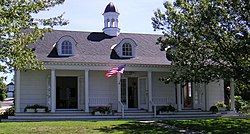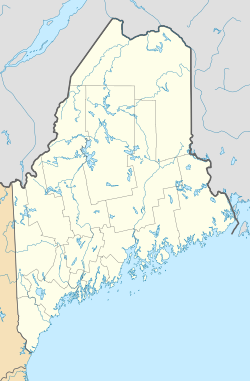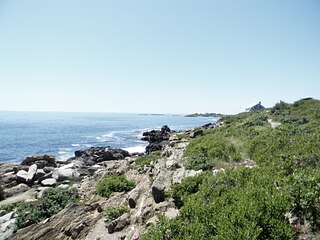
Bailey Island is an island in Casco Bay, and a part of the town of Harpswell, in Cumberland County, Maine, United States. As of the 2000 census, the island had a year-round population of 400.

Eagle Island is an island in Maine's Casco Bay and the site of the summer home of the North Pole explorer Admiral Robert Peary (1856-1920). The island and home are preserved as the Eagle Island State Historic Site.
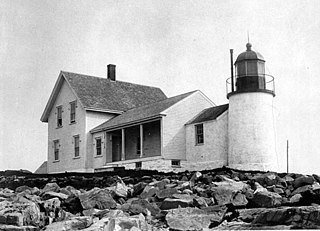
Winter Harbor Light is a lighthouse in Winter Harbor, Maine. It is located on Mark Island, a small island between the Schoodic Peninsula and Turtle Island, near the entry to the town's main harbor. The light was built in 1856 and was deactivated in 1933; it is no longer an aid to navigation, and is privately owned. The light was listed on the National Register of Historic Places as Winter Harbor Light Station on February 1, 1988.

The East Harpswell Free Will Baptist Church is a historic church on Cundys Harbor Road in East Harpswell, Maine. Built in 1843, it is a little-altered modest Greek Revival structure, with a reversed interior layout that is now extremely rare within the state. It has been used only sporadically since the early 20th century, but is maintained by a local community group. The building was listed on the National Register of Historic Places in 1988.

Union Church is a historic church on Harpswell Neck Road in North Harpswell, Maine. Built in 1841, it is architecturally a distinctive and well-preserved combination of Greek Revival and Gothic Revival styles. It was used over the years by a variety of religious groups, and is now maintained by the Harpswell Garden Club. The building was listed on the National Register of Historic Places in 1988.

The South China Meeting House, now known as the South China Community Church, is a historic church on Village Street in South China, Maine. Built in 1884 as a Quaker meeting house, it is now home to multi-denominational congregation. It is notable as one of the places that influenced Quaker writer Rufus Jones, who was raised in South China and attended services here after this building replaced the Pond Meeting House. It was listed on the National Register of Historic Places in 1983.
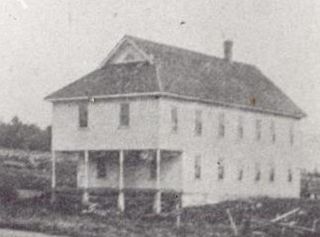
The Oakfield Grange was an historic clubhouse and community meeting space at 89 Ridge Road in Oakfield, Maine. Built in 1906 by the local chapter of the Patrons of Husbandry, the building was for many years the sole social meeting space of any size in the small rural community. It was listed on the National Register of Historic Places in 2006. It has since been demolished, and was delisted in 2023.

The William Fogg Library is the public library of Eliot, Maine. It is located at the junction of Old and State Roads, in an architecturally distinguished building constructed in 1907 via a bequest from Dr. John S. H. Fogg in memory of his father William. The building was designed by C. Howard Walker, and was listed on the National Register of Historic Places on December 21, 1991.
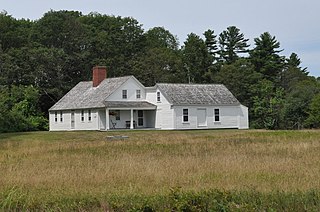
The Tarr–Eaton House, also known as Tarr–Eaton–Hackett House, is an historic house at 906 Harpswell Neck Road in Harpswell, Maine. Built before 1783 and enlarged about 1840, it is a well-preserved 18th-century Cape with added Greek Revival features, and one of Harpswell's few surviving pre-Revolutionary War buildings. It was listed on the National Register of Historic Places in 2001.

The Elijah Kellogg House is an historic house on Barton Lane in Harpswell, Maine. It is a well-preserved Greek Revival house, built in 1849 by Elijah Kellogg, a Congregationalist minister at the nearby church, and a lecturer and author of popular boy's adventure books. The house was listed on the National Register of Historic Places on April 28, 1975.

The George Bemis House is a historic house on Chesham Road in Harrisville, New Hampshire. Built in 1852, it is a good local example of Greek Revival architecture, and a near duplicate of the adjacent Elbridge G. Bemis House. The house was listed on the National Register of Historic Places in 1988.

The Former Town House of Salem, Maine, now the Salem Community Building, is located on Maine State Route 142, a short way west of Mt. Abram Regional High School. Completed in 1858, it is the only civic building built during the existence of the municipality, which was established in 1823 and disincorporated in 1945. The church-like building is architecturally notable for its Italianate styling, and for its social history as the site of community social and government activity. The building was listed on the National Register of Historic Places in 2005.

The Auburn–Harpswell Association Historic District encompasses a well-preserved enclave of summer residences built in the early 20th century in southern Harpswell, Maine. The district includes ten Shingle style houses, a Colonial Revival dining hall, and a Greek Revival meeting hall. The Auburn Colony, an exclusive company of businessmen from Auburn, Maine, was responsible for their development. The district was listed on the National Register of Historic Places in 1985.

The Bellows Falls Times Building is a historic newspaper plant on Bridge and Island Streets in Bellows Falls, Vermont. The complex of three buildings was developed in the 1930s by the Vermont Newspaper Corporation, and served as home for the Bellows Falls Times newspaper until 1965, when it was consolidated with other local newspapers. The main building is a particularly fine local example of Colonial Revival design. The complex was listed on the National Register of Historic Places in 1990.
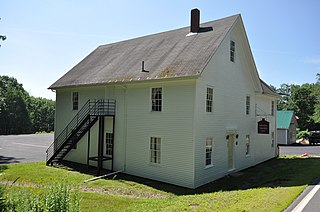
The Bremen Town House, formerly Bremen Town Hall is a historic municipal building on Maine State Route 32 in Bremen, Maine. Built in 1874 and sympathetically enlarged in 1938, it served for many years as the community's town hall, and continues to serve the community as one of its major social gathering points. The building was listed on the National Register of Historic Places in 2000.
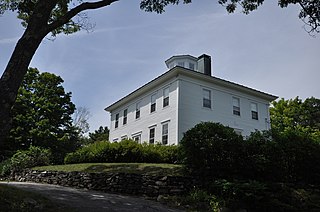
The Union Hotel is a historic hotel building at 926 Cundy's Harbor Road in the Cundy's Harbor village of Harpswell, Maine. Built in 1862, it is believed to be the oldest purpose-built summer resort hotel in the state. It was listed on the National Register of Historic Places in 1985. It now houses the Captain's Watch Bed and Breakfast.
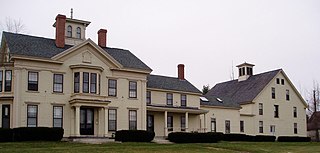
The Moses Bailey House is a historic house at 209 Winthrop Center Road in the Winthrop Center village of Winthrop, Maine. Built about 1853, with additional Italianate styling added in 1870, it is one of Winthrop's finest surviving mid 19th-century farm houses. It was listed on the National Register of Historic Places in 1984. It has been divided into apartments and is known as Bailey Manor.

The Ludlow Graded School is a historic former school building at 10 High Street in the village of Ludlow, Vermont. Built in 1871–72, the school was for many years the primary school feeding the adjacent Black River Academy. The building now serves as a local senior services center. It was listed on the National Register of Historic Places in 1979.

The Ira Hill House is a historic house at 2304 Main Streets in Isle La Motte, Vermont. Built in 1822 for a prominent local citizen by James Ritchie, a regionally acclaimed stonemason, it is one of the rural community's finer stone houses of the period. It was listed on the National Register of Historic Places in 2003.

The Old Red Mill and Mill House are a historic 19th-century mill building and residence on Red Mill Drive in Jericho, Vermont. The mill was built in 1856 and enlarged later in the 19th century, accommodating then state-of-the art grain rollers, and was a prominent local business. The house was built in 1859, and is a good local example of Gothic Revival architecture. The mill is now a museum property of the local Jericho Historical Society. The mill building was listed on the National Register of Historic Places in 1972; the listing was expanded to include the house in 1976.
